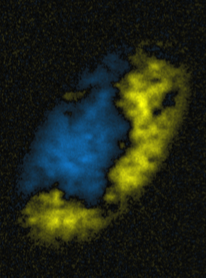Dispersion Engineering with Cold Atoms: Ferromagnetism, Rotons, and Beyond

Speaker(s): Colin V. Parker (’06)
For classical or quantum Hamiltonians, one typically writes the kinetic energy, or dispersion, as a simple parabola for small momentum. However, particles traveling in certain periodic potentials (i.e. lattices) may have a dispersion that is minimized at multiple values of momentum or that depends upon the fourth power of momentum, preventing such a simple description. My collaborators and I have realized these “engineered dispersions” experimentally by shaking cold cesium atoms back and forth in optical standing waves. Despite the fact that our atoms experience only short-range interactions, we observe behavior typically seen in strongly interacting condensed matter systems. For example, the atoms form domains like a ferromagnet (see image) despite having fixed spin. We also observe a set of excitations called rotons, first observed in superfluid helium, in which the phase and group velocity point in opposite directions. These experiments demonstrate the important role played by lattice-generated dispersion in many-body systems.